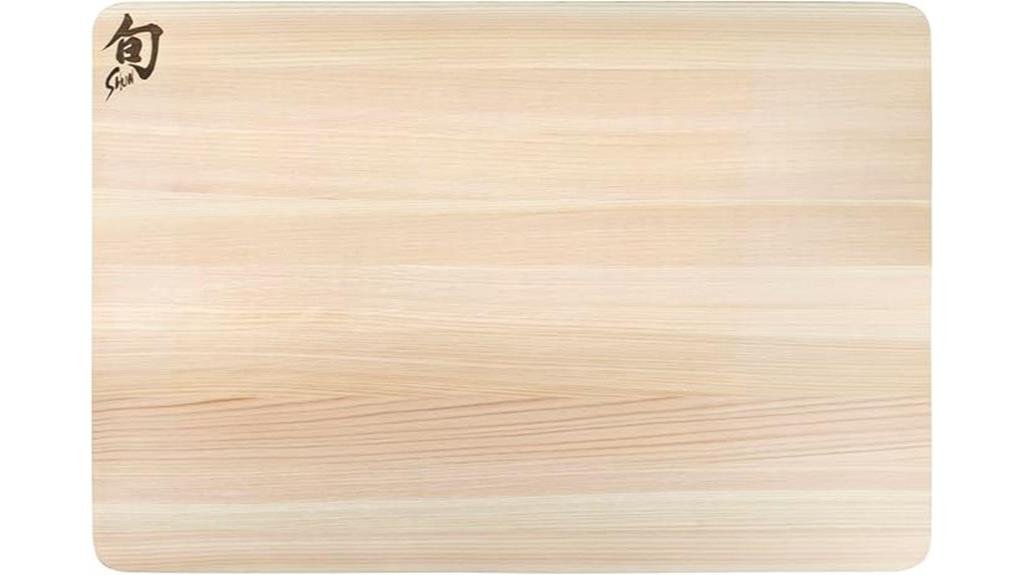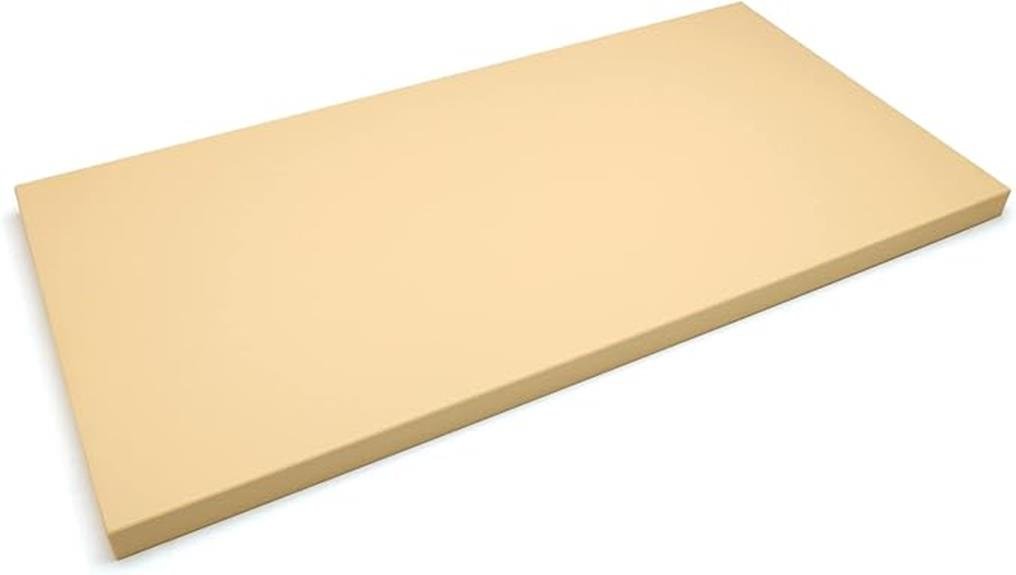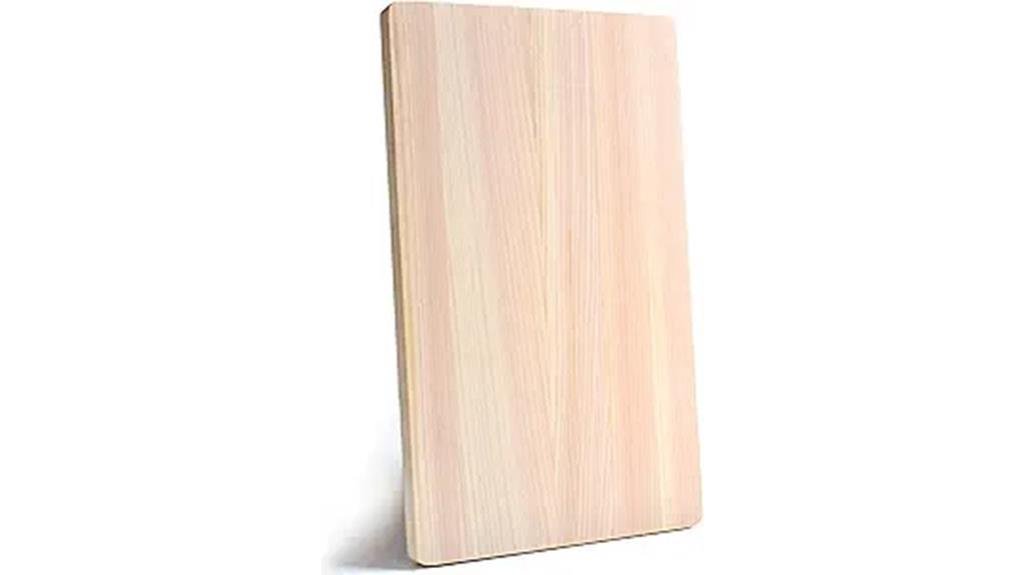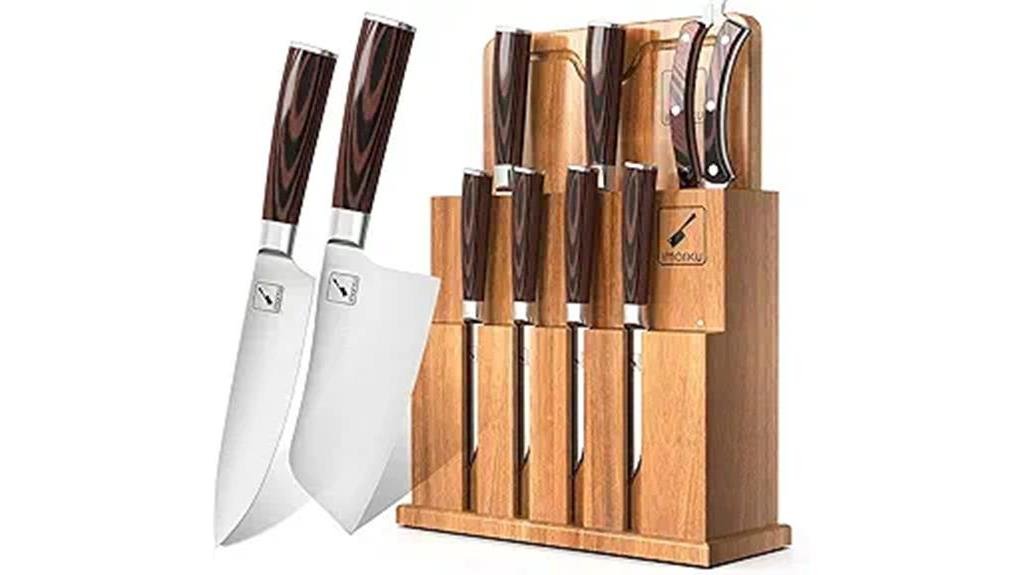When searching for the best chopping board for your Japanese knives, you'll want to weigh materials that preserve the blade's edge and longevity. Top options include the Shun Cutlery Medium Hinoki Cutting Board, made from sustainable Japanese cypress, and the Yoshihiro Hi Soft High Performance Cutting Board, featuring high-quality LDPE plastic that reduces knife stress. The Japanese Hinoki Cutting Board – Large and Mitsumoto Sakari Japanese Acacia Wood Cutting Board offer eco-friendly alternatives with natural moisture resistance. For a complete kitchen solution, ponder the imarku 11-Piece Professional Kitchen Knife Set, which includes a high-quality chopping board. Delve into these options further to find the ideal chopping board that complements your Japanese knives.
The TLDR
- Hinoki wood chopping boards, like the Shun Cutlery Medium Hinoki Cutting Board, are a popular choice for Japanese knives due to their natural ability to preserve knife edges.
- LDPE plastic chopping boards, such as the Yoshihiro Hi Soft High Performance Cutting Board, minimize stress on hands and impact on blades, resulting in better edge retention and longer lifespan for knives.
- Acacia wood chopping boards, like the Mitsumoto Sakari Japanese Acacia Wood Cutting Board, offer a sustainable and eco-friendly option that's less prone to knife marks, scratches, and warping.
- Consider a chopping board with a parallel wood grain direction, like the Japanese Hinoki Cutting Board – Large, to reduce scratches and knife marks.
- Look for a chopping board with a smooth, non-porous surface, such as LDPE plastic or hinoki wood, for easy cleaning and maintenance.
Shun Cutlery Medium Hinoki Cutting Board

If you're a serious home cook or professional chef seeking the perfect cutting board to pair with your prized Japanese knives, the Shun Cutlery Medium Hinoki Cutting Board is an excellent choice. This cutting board is made from hinoki, a type of Japanese cypress renowned for its beauty and natural fragrance. The medium-soft wood is perfect for general-purpose tasks, measuring 15.75 x 10.75 inches, and is compact for easy storage. As a Forest Stewardship Council Certified product, you can trust that it's made with sustainable forest management practices. With proper care, including wetting before each use and washing with mild detergent, this cutting board will preserve your knife edges and remain a trusted companion in the kitchen.
Best For: Serious home cooks or professional chefs seeking a high-quality cutting board to pair with their Japanese knives.
Pros:
- Lightweight and soft wood that is gentle on knives
- Compact size makes it easy to store and perfect for general-purpose tasks
- Made with sustainable forest management practices and certified by the Forest Stewardship Council
Cons:
- Some customers have reported that the cutting board stains easily
- May warp when exposed to water if not properly cared for
- Requires regular maintenance, including wetting before each use and washing with mild detergent
Yoshihiro Hi Soft High Performance Cutting Board

In regards to pairing your high-carbon steel Japanese knives with a cutting board that truly understands their needs, the Yoshihiro Hi Soft High Performance Cutting Board is an excellent choice. This cutting board is designed to reduce stress on your hands and impact on your blades, resulting in better edge retention and a longer lifespan for your knives. Made from high-quality LDPE plastic, the board's soft surface minimizes wear and tear on your knives, while its heavy and sturdy design prevents slipping and movement during use. You'll appreciate the quiet and smooth cutting experience it provides, making it an ideal choice for those who value precision and control.
Best For: Chefs and home cooks who value precision and control and want to extend the lifespan of their high-carbon steel Japanese knives.
Pros:
- Minimizes stress on hands and impact on blades, resulting in better edge retention and longer lifespan for knives
- Provides a quiet and smooth cutting experience
- Easy to clean and maintain, with odor resistance and stain prevention
Cons:
- Sensitive to heat and may stain if not properly maintained
- Heavy design may be cumbersome for some users
- Not suitable for use with serrated knives
Japanese Hinoki Cutting Board – Large

For those seeking a cutting board that embodies the essence of Japanese craftsmanship, the Japanese Hinoki Cutting Board – Large is an excellent choice. This rectangular cutting board measures 16.53 inches long, 9.44 inches wide, and 0.59 inches thick, making it a spacious surface for chopping and preparing fruits and vegetables. Made from natural cypress wood, it emits a fresh, cedary-like wood smell that many users appreciate. You'll find it lightweight and easy to handle, with a durable design that's built to last. Be sure to hand wash it only, as specified in the product care instructions, to maintain its longevity. With a 4.4-star rating from 62 customers, this cutting board has earned its spot as a top choice for those seeking a high-quality, Japanese-made cutting board.
Best For: Those who value high-quality, Japanese-made cutting boards with a natural wood smell and are willing to follow hand washing care instructions.
Pros:
- Made from natural cypress wood, providing a fresh cedary-like wood smell
- Lightweight and easy to handle and clean
- Long-lasting and durable, suitable for chopping and preparing fruits and vegetables
Cons:
- Some customers mentioned a strong scent, which may be a drawback for those with sensitivities
- A few customers experienced issues with the board warping or chipping when exposed to water
- One customer found the board to be too small for their needs
Mitsumoto Sakari Japanese Acacia Wood Cutting Board

With its sustainably sourced Acacia wood construction, the Mitsumoto Sakari Japanese Acacia Wood Cutting Board stands out as an ideal choice for those prioritizing eco-friendliness and durability in their kitchen arsenal. You'll appreciate the fine grain of the wood, which guarantees long-lasting performance and lessens the likelihood of knife marks and scratches. The deep juice groove design is a thoughtful touch, catching liquids during cutting and making cleanup a breeze. As a bonus, this board can double as an elegant serving tray for cheese, grilled meats, and appetizers, making it a valuable enhancement to your kitchen.
Best For: Those who prioritize eco-friendliness, durability, and versatility in their kitchen cutting boards.
Pros:
- Made from sustainably sourced Acacia wood, ensuring a durable and long-lasting performance
- Features a deep juice groove design that catches liquids during cutting, making cleanup easy
- Can be used as an elegant serving tray for cheese, grilled meats, and appetizers, adding versatility to its functionality
Cons:
- Requires periodic application of food-grade mineral oil to maintain its luster
- Hand washing only, which may be inconvenient for some users
- May be heavier than other cutting boards due to its durable construction
imarku 11-Piece Professional Kitchen Knife Set

You'll love the imarku 11-Piece Professional Kitchen Knife Set if you're looking for a thorough kitchen solution that includes a high-quality chopping board, perfect for pairing with your Japanese knives. This all-inclusive set comes with everything you need, including a chef's knife, slicing knife, bread knife, scissors, sharpening steel, four steak knives, and a wooden cutting board. The high-quality Japanese stainless steel blades feature sharp edges for precision cutting, while the comfortable and stylish colorful wooden handles guarantee safety during handling. The wooden cutting board complements the knives perfectly, offering a complete solution for your chopping and slicing needs that certifies a worry-free experience.
Best For: Those who want a comprehensive kitchen knife set with high-quality Japanese stainless steel blades and a wooden cutting board for a worry-free cooking experience.
Pros:
- The set includes a wide range of essential kitchen tools, including a chef's knife, slicing knife, bread knife, scissors, sharpening steel, and four steak knives.
- The high-quality Japanese stainless steel blades feature sharp edges for precision cutting, and the comfortable wooden handles ensure safety during handling.
- The set also includes a high-quality wooden cutting board that complements the knives perfectly, offering a complete solution for chopping and slicing needs.
Cons:
- Some customers have reported receiving broken or damaged products, which can be frustrating and inconvenient.
- The set's construction type is forged, which may not be as durable as some other construction types.
- The product warranty information is only available upon request, which may not provide sufficient assurance for some customers.
Factors to Consider When Choosing a Chopping Board for Japanese Knives
When choosing a chopping board for your Japanese knives, you're not just looking for any old surface to chop on – you need a board that will safeguard your knives and make food preparation a breeze. You'll want to ponder factors like the material quality, wood grain direction, and size and portability of the board to guarantee it meets your needs. By taking these key factors into account, you'll be able to find a chopping board that preserves your knife edges, resists moisture, and becomes a vital tool in your kitchen.
Material Quality Matters
Selecting the right chopping board for your Japanese knives is crucial, as the material quality directly impacts the performance and longevity of your blades. You want a board that complements the material and construction of your knives, ensuring peak performance and edge retention. Hinoki wood, for instance, is a popular choice for high-quality cutting boards due to its natural ability to preserve knife edges. LDPE plastic is another option that minimizes stress on hands and impact on blades, resulting in better edge retention and longer lifespan for knives. Acacia wood, known for its hardness and durability, is a sustainable and eco-friendly option that's less prone to knife marks, scratches, and warping. The quality of the material used in a cutting board can directly affect the performance and longevity of Japanese knives. Furthermore, the material can also impact its maintenance and care, with some materials requiring periodic oil application or special cleaning products to maintain their appearance and functionality.
Wood Grain Direction
Most chopping boards feature a wood grain direction that's either parallel or perpendicular to the cutting surface. You'll want to weigh this factor when choosing a chopping board for your Japanese knives, as it affects the board's durability and performance. A parallel wood grain direction means the wood fibers run along the length of the board, parallel to the cutting surface. This design helps to reduce scratches and knife marks, as the wood fibers absorb the impact of the knife. On the other hand, a perpendicular wood grain direction means the fibers run across the width of the board, perpendicular to the cutting surface. This design can be more prone to scratches and marks, but it's often preferred by chefs who value the self-healing properties of the wood.
When using a Japanese knife, you'll want to ponder a chopping board that can withstand the precision and sharpness of the blade. A parallel wood grain direction is generally recommended, as it provides a smoother cutting surface and reduces the risk of damage to the board. However, some cooks prefer the feel and performance of a perpendicular wood grain direction. Ultimately, the choice depends on your personal preference and cooking style.
Size and Portability
As you shop for a chopping board to pair with your Japanese knives, consider how much real estate you need to prep ingredients and how easily you can take your board on the go. A larger chopping board provides more surface area, but it may be less portable and more difficult to store. On the other hand, a smaller board is more convenient for travel or small kitchens.
A good balance between functionality and portability can be achieved with a chopping board measuring between 15-18 inches in length and 10-12 inches in width. However, the weight of the board is also vital. A heavier board can provide stability and prevent slipping during use, but it may be more cumbersome to transport or store.
If you're planning to use your chopping board for camping, picnics, or small gatherings, a compact and lightweight option is ideal. It can be easily stowed away in a backpack or cabinet. Ultimately, consider the size and weight that best suits your specific needs and cooking habits, whether at home or on-the-go.
Knife Edge Preservation
When you're investing in a high-quality Japanese knife, you want to make certain you're pairing it with a chopping board that will help preserve its edge. A cutting board made from hinoki, a type of Japanese cypress, is an ideal choice as its medium-soft wood is gentle on blades, reducing wear and tear. Alternatively, a soft surface like LDPE plastic can also minimize stress on your hands and the impact on blades, resulting in better edge retention and a longer lifespan for your knives.
Additionally, consider a cutting board with a fine grain, such as those made from sustainably sourced Acacia wood. This guarantees long-lasting performance and reduces the likelihood of knife marks, scratches, and warping. It's also vital to choose a cutting board that's easy to clean and maintain, as this will help preserve your knife's edge. Regularly cleaning and maintaining your cutting board, including applying food-grade mineral oil to maintain the wood's luster, can also extend the lifespan of both your knife and board.
Moisture Resistance Ability
While pairing your Japanese knife with the right chopping board is crucial, ensuring that board can withstand moisture is equally indispensable. A chopping board with high moisture resistance ability can prevent warping, cracking, and staining, ensuring a longer lifespan and easier maintenance. Look for boards made from materials like LDPE plastic, hinoki wood, or acacia wood, which have natural properties that repel water and humidity. You can also boost a board's moisture resistance through proper care and maintenance, such as hand washing, drying, and applying food-grade mineral oil periodically. Furthermore, boards with deep juice grooves or channels can help redirect moisture away from the cutting surface, reducing the risk of warping or staining. When choosing a board, consider certifications like Forest Stewardship Council (FSC) or sustainably sourced materials, which often have inherent moisture-resistant properties. In this respect, prioritizing moisture resistance will yield a durable and low-maintenance chopping board that complements your Japanese knife perfectly.
Easy Cleaning Features
With your Japanese knife by your side, a chopping board that's easy to clean is crucial for a seamless cooking experience. You'll want a board that allows you to focus on cooking, not scrubbing away at last night's dinner. Look for a cutting board with a smooth, non-porous surface, such as LDPE plastic or certain types of wood like hinoki. These surfaces prevent bacteria from accumulating, making cleaning a breeze. A juice groove design is also a must-have, as it catches liquids during cutting, making cleanup more efficient. When it's time to clean, hand washing with mild soap and water is the way to go. Avoid using abrasive cleaners or scouring pads, as they can scratch or damage the board's surface. Some boards, like those made from Acacia wood, may require periodic application of food-grade mineral oil to maintain their luster and prevent drying out. By choosing a chopping board with easy cleaning features, you'll save time and effort in the kitchen, and guarantee a safe and healthy cooking environment.
Durability and Longevity
Your Japanese knife's sharpness demands a chopping board that can keep up, and that means prioritizing durability and longevity. A durable chopping board can withstand the sharpness and frequency of use of Japanese knives, ensuring a long-lasting performance and reducing the need for frequent replacements. The material of the chopping board plays a vital role in its durability, with high-quality materials like hinoki wood and LDPE plastic offering better resistance to scratches and cracks.
You should also consider the weight and thickness of the chopping board, as heavier and thicker boards are less prone to warping or cracking under heavy use. Proper maintenance is essential, too – regular cleaning and hand washing can help extend the life of a chopping board and prevent the growth of bacteria and other microorganisms. Avoid exposing your chopping board to high heat or harsh chemicals, as these can markedly reduce its lifespan. By choosing a durable chopping board and maintaining it properly, you can enjoy years of reliable performance.
Frequently Asked Questions
Can I Use a Chopping Board With a Dishwasher?
You're wondering if you can toss your chopping board in the dishwasher – the answer's not so simple. It depends on the material: wood and bamboo are a no-go, but plastic, rubber, and some composite boards might be okay, so always check the manufacturer's guidelines.
Will a Wooden Board Warp if Exposed to High Humidity?
You're wondering if wooden boards can handle humidity; the answer is, it depends on the type of wood and how well you maintain it – if it's not properly seasoned or sealed, warping is likely, but with proper care, it'll stay straight.
How Often Should I Oil My Wooden Chopping Board?
You should oil your wooden chopping board every 1-3 months, depending on usage, to keep it hydrated and prevent cracks. Simply apply a food-safe oil, let it sit, and wipe off excess for a protected and durable board.
Are Bamboo Chopping Boards Suitable for Japanese Knives?
You're wondering if bamboo chopping boards are suitable for your knives in general. They're a great eco-friendly option, but bamboo's softness can lead to scratches and damage from sharp blades, including Japanese knives, so extra care is necessary.
Can I Cut Frozen Meat on a Wooden Chopping Board?
You shouldn't cut frozen meat on a wooden chopping board, as it can harbor bacteria and cause cracks; instead, you'll want to thaw the meat initially or use a dedicated cutting board for raw meat.
Conclusion
You've narrowed down your search for the perfect chopping board for your Japanese knives to the top five options. Now, you're equipped with the knowledge to make an informed decision. Consider the durability, maintenance, and performance of each board, and think about your personal preferences and cooking style. With the right chopping board, you'll be able to tap the full potential of your Japanese knives and take your cooking to the next level.